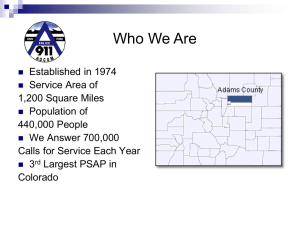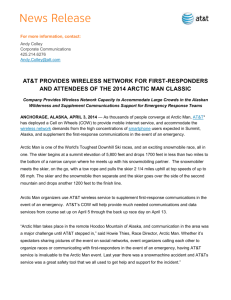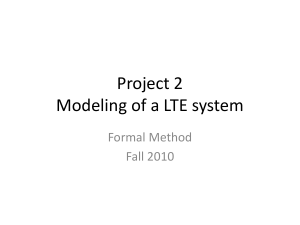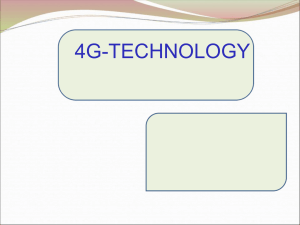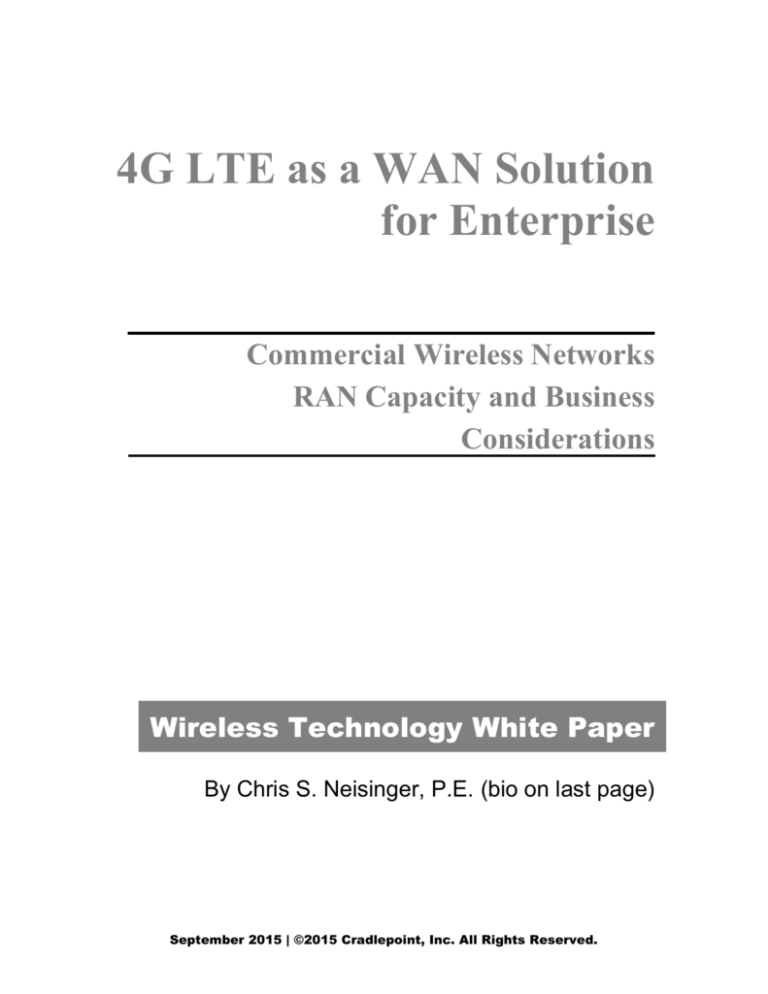
4G LTE as a WAN Solution
for Enterprise
Commercial Wireless Networks
RAN Capacity and Business
Considerations
Wireless Technology White Paper
By Chris S. Neisinger, P.E. (bio on last page)
September 2015 | ©2015 Cradlepoint, Inc. All Rights Reserved.
Contents
Executive Summary ...................................................................................................................... 3
Introduction ................................................................................................................................... 4
RAN Solutions Support Capacity and Efficiency .................................................................. 7
Spectrum Augmentation .................................................................................................................... 9
Scheduler Improvements.................................................................................................................... 9
Interference Cancelation ..................................................................................................................... 9
Interference Reduction through Design (SON) ............................................................................. 10
Co-Ordinated Multi-Point (CoMP) ................................................................................................. 10
C-RAN/Cloud RAN .......................................................................................................................... 10
Carrier Aggregation .......................................................................................................................... 10
Small Cell for Efficiency vs Coverage ............................................................................................. 10
Application Aware Scheduling ....................................................................................................... 11
Edge Processing and Distributed Architectures ............................................................................ 11
Other Technology Improvements ................................................................................................... 12
The Business Landscape ........................................................................................................... 13
Applications ................................................................................................................................ 15
Conclusions ................................................................................................................................. 17
September 2015
Page 2
©2015 Cradlepoint, Inc. All Rights Reserved.
CSN Consulting
1
Section
Executive Summary
The advent of 4G LTE has been transformational in the wireless industry.
Service providers like Verizon, O2, Vodafone, and Telefonica (and may others
worldwide) have focused on data performance, quality and resiliency; and now
LTE wireless networks have become as reliable as or arguably even more reliable
than traditional fixed networks.
LTE has a fundamentally strong ecosystem. There is ongoing development that
is delivering capacity solutions to meet the ever-growing demand.
4G LTE is a viable transport technology to support many enterprise use cases as
a primary WAN source. The majority of enterprise use cases at
distributed/branch/remote locations can benefit from the simple, flexible and cost
effective LTE last mile solution, even in the face of ever-escalating data usage.
This paper looks at the network service providers’ capacity enhancement
techniques, the business landscape and potential applications of 4G LTE as a
primary WAN solution.
Like any wireless solution, LTE does not meet all needs in all places. However, if
the enterprise use case can be supported and there is quality signal at the
location, adopting an LTE backhaul solution can bring agility, reliability and cost
savings to your business.
September 2015
Page 3
©2015 Cradlepoint, Inc. All Rights Reserved.
CSN Consulting
Section
2
Introduction
There is a clear and sustainable demand trend for wireless data. The 2015
wireless industry predicts 57% compound annualized growth through the end of
the decade. Much of the basis for this growth is due to the proliferation of
smartphones and the introduction of high capacity LTE networks.
Source: Cisco VNI Mobile, 2015
4G LTE was launched in the U.S. on single band 2x10 MHz spectrum blocks.
This provided higher capacity per spectrum resource than the legacy 3G
networks, but the capacity was quickly taken up by user demand. The industry
anticipated this demand, and multiple frequency bands were added/converted to
4G. The LTE radio technology is the most advanced wide area wireless data
solution in the world.
Long Term Evolution is not an interim technology. 4G LTE can and will
continue to evolve to support the ever increasing demands from business and
consumer wireless users.
4G LTE is the first truly global standard for wireless wide area networks, and it is
completely replacing the bifurcated 3G technologies. The competing standards
in 3G resulted in multiple device SKUs, split R&D budgets and higher
September 2015
Page 4
©2015 Cradlepoint, Inc. All Rights Reserved.
CSN Consulting
manufacturing costs. The complete global acceptance of 4G LTE has led to very
steep volume-based decline in network and device hardware.
Another significant attribute is the acceptance of wireless as the “most reliable”
method of communication. Wireless was originally just a convenient method of
communicating when away from home or office, and was accepted as a
secondary line. The simplicity and ubiquity of wireless led to the migration of
minutes from the primary landline to the wireless phone. Service providers
invested in reliability and customers noticed. Wireless voice became adopted as
primary. Events like Hurricane Katrina and Super-storm Sandy demonstrated
that wireless service was more reliable and much faster to restore than landlines.
Services quality and reliability of 4G LTE is no longer at question. Consumers
and Businesses are moving from LTE as solely a backup/service restoration type
of technology towards mission critical primary use cases. The wireless ubiquity
and unique security posture of 4G LTE can enable transformative business
processes.
There are three factors to consider in determining if your location is suitable for
LTE backhaul.
We have addressed Reliability. Throughout the world, the major service
providers have definitely created sufficient overall core network reliability. In
addition, most physical locations have cell coverage from multiple towers. This
provides another layer of redundancy. If even further redundancy is required,
dual modems with multi-Carrier support can be deployed.
Signal Quality is a combination of signal strength, intersystem interference (the
wireless operator’s cell site design) and “other users” impact to localized
capacity. A simple site survey procedure with an LTE modem running various
test traffic profiles can easily demonstrate if a location has sufficient signal
quality.
The final consideration is the business Application or Usage Profile. The
majority of enterprise transactional applications are well suited for wireless
backhaul without modification. Many enterprise video applications can also be
September 2015
Page 5
©2015 Cradlepoint, Inc. All Rights Reserved.
CSN Consulting
supported natively, while other higher resolution video applications can be
supported with the inclusion of edge processing and content adaptation.
Service Providers are growing their LTE wireless network capacity in support of
the user demand. This network growth will be on 4G LTE. There have been
recent discussions on 5G, but 5G will not appear anytime soon and when it does,
it will interwork with LTE. The 5G evolution is being designed to provide
localized very high bandwidth that complements the wide area 4G service. 5G
will not replace LTE the way 4G replaced 3G.
September 2015
Page 6
©2015 Cradlepoint, Inc. All Rights Reserved.
CSN Consulting
Section
3
RAN Solutions Support Capacity and
Efficiency
The Radio Access Network (RAN) is the linchpin of overall Network Capacity in
any wide area wireless network. The 4G LTE RAN technology is the most
advanced in the world. There are advances in LTE that are bringing more
capacity and higher efficiency.
The initial phase of the cellular industry was all focused on building out
coverage. In that paradigm more sites, higher towers, and stronger signals led to
more ubiquitous voice service. The more Bars the Better. The cellular service
providers honed their processes and became very good at providing voice
service coverage by building macro cell base stations.
This initial phase was followed by a massive expansion of voice usage from
landline migration and then the unprecedented adoption of wireless data. The
focus of the wireless operators shifted from voice to data. The wireless carriers
responded to the data tsunami primarily through spectrum augmentation and
their tried and true macro cell buildout processes; add sites, add next carrier; add
next spectrum band. Acquiring spectrum was paramount.
September 2015
Page 7
©2015 Cradlepoint, Inc. All Rights Reserved.
CSN Consulting
The previous capacity expansion methods for voice were not always suitable for
data. Five Bars of coverage does not mean great data performance. Data
optimization technologies were developed and deployed. A shift in design
paradigm from voice centric to data centric began to take hold. The current focus
of the wireless providers is now firmly data centric.
Capacity and service quality are not enough. Ten times the capacity at ten times
the cost does not enable transformation. The dramatic improvement in efficiency
came via technology migration.
For example, the migration from Analog voice to Digital voice (TDMA or
CDMA) enabled an order of magnitude more voice capacity at half the cost. The
“More for Less” synergy was an enabling factor in the wireless business
transformation. What was originally a high cost mobile phone business for
executives became a fully capable landline telephony replacement business for
the entire consumer market.
Similarly, the data service radio technology migration to scheduler-based High
Rate Packet Data (HRPD) massively increased the spectral efficiency to allow
Wireless Network Operators to market cost effective 3G data plans. The cost per
bit to provide wide area wireless service took another steep decline. And now
the Radio Technology Evolution has culminated with an extremely spectrally
efficient OFDMA based 4G LTE technology as the single worldwide standard. In
fact, 4G LTE has been shown to be within five percent of the theoretical Shannon
limit. The Shannon theorem states that there is a maximum rate of information
that can be transmitted over a communication channel in the presence of noise.
As the noise decreases, the information rate also increases, but is bounded as
shown on the chart.
September 2015
Page 8
©2015 Cradlepoint, Inc. All Rights Reserved.
CSN Consulting
So what is next? Are we at a capacity brick wall with LTE?
No. We are nowhere near the brick wall of capacity, nor are we at the end of the
declining cost per bit curve. However, the methods to achieve these gains are
changing. New methods must provide both capacity and efficiency. The cost
per bit will continue to improve. Service providers will grow their networks to
support higher usage.
Capacity Enhancement Vectors
Spectrum Augmentation
Scheduler Improvements
Intercerence Cancelation
Intercerence Reduction through Design
CoMP
C-RAN
Carrier Aggregation
Small Cells (for efficiency/not small macrocells)
Multi RAT and Helper Networks
Application Aware Scheduling
Edge Processing (Fog Computing and caching)
Distributed Architecture
Capacity
x
x
x
x
x
x
x
xx
xx
xx
x
x
Performance/C
apabilities
Cost/Efficiency
x
x
x
x
x
x
x
x
This chart lists some capacity enhancement methods being deployed now or in
the near future in most major LTE operator networks.
Spectrum Augmentation
Additional Spectrum is the most straightforward method of growing capacity.
An initial coverage layer of spectrum with at least 10 MHz downlink and 10
MHz uplink is sufficient for high quality data services. This enables solid 2 to 4
MHz low latency wide area services. Additional spectrum is added in blocks of
at least 5 MHz such as AWS or PCS frequency bands.
Scheduler Improvements
The scheduler is designed to fairly apportion resources to multiple users based
on their individual data queue and estimated Radio Channel conditions.
Improvements in this process result in more efficient resource allocation and
higher total throughput per base station.
Interference Cancelation
Interference control is one of the most significant capacity and efficiency vectors.
As stated earlier, LTE is within five percent of the Shannon limit. It is difficult to
make future generational improvements if you are already at 95 percent of the
maximum. However, the Shannon limit equation is for a channel in the presence
September 2015
Page 9
©2015 Cradlepoint, Inc. All Rights Reserved.
CSN Consulting
xx
xx
xx
xx
xx
of interference. Removing, avoiding or otherwise eliminating interference
allows us to “move up and to the right” on the Shannon curve. Interference
Cancelation may allow a typical LTE network to move from operating at 1 to 2
bits per second per Hz to a range of 4 or 6 or even 8 bits/s/Hz. This can double,
triple or in some places quadruple the capacity of the RAN.
Interference Reduction through Design (SON)
Optimized cell site location, antenna configurations and antenna downtilt will
reduce the overall interference. As interference goes down, efficiency goes up,
capacity goes up and cost comes down. Automation is being used to achieve
optimal configurations. Real time automation tools are being implemented such
as SON (Self Organizing Network).
Co-Ordinated Multi-Point (CoMP)
CoMP is an LTE Advanced feature that combines signals from multiple base
stations to take advantage of special diversity in the radio channel. The capacity
gains come from a combination of Coordinated Scheduling, Coordinated
Antenna Beamforming, and Joint Transmission.
C-RAN/Cloud RAN
There are several new methods being deployed to bring the advantages of
“cloud” to the Radio Access Network. C-RAN enables cost effective
centralization of baseband radio functions (L2 and L3) with remote radio head
units (L2 and L1). C-RAN in itself does not increase capacity, but it provides
lower operating costs to the service providers and it enables implementation of
capacity enhancement features such as CoMP.
Carrier Aggregation
Carrier Aggregation enables a device to use frequencies from multiple bands.
This improves peak speeds and greatly improves spectrum utilization. Verizon’s
X-LTE service launched as multi carrier LTE (700 Mhz, AWS and PCS) was the
first advancement towards carrier aggregation. Currently devices load balance
across the carriers, but a device only operates in one band at a time. However, as
devices become compatible, carrier aggregation will enable a single device to use
multiple bands simultaneously.
Small Cell for Efficiency vs Coverage
Early deployment of small cells was mainly to fill coverage holes. These small
cell deployments are very inefficient. Implementing Small Cells with C-RAN
and CoMP features enable in very high efficiency.
September 2015
Page 10
©2015 Cradlepoint, Inc. All Rights Reserved.
CSN Consulting
The scheduling decision for the microcell needs to be made at the same time and
location as the macrocell scheduling decision. If the microcell scheduler cannot
achieve 4 b/S/Hz then fall back and deliver over the macrocell. This coordinated
scheduling method creates a system with minimal overlapping signal
interference. Furthermore, the lower the interference, the higher the capacity.
For this coordinated scheduling and fallback transport to work, we need a CRAN transport architecture.
Application Aware Scheduling
All applications are not the same. Why should they be treated the same as they
transit the network? The Net Neutrality debate a few years ago incorrectly
positioned this network management technique as unfair prioritization of one
customer’s traffic over that of another. As the early rhetoric has lifted, it has
becoming clear that there is absolutely a place for application aware scheduling.
One simple example is the ability of the scheduler to deliver background
applications (applications with no user interaction) at a “scheduling rate” that
maximizes total system capacity instead of a rate that schedules average resource
to each active device.
While some may still argue over Net Neutrality, I argue that there is significant
end customer benefit from Application Aware Scheduling. If Net Neutrality is
really about benefits to the end user, then the customer value of application
based scheduling will win out. Sometime in the near future, these methods will
be implemented either in the applications themselves or via an Application
Aware Scheduler. Either way, this will double or triple the effective capacity of
the RAN.
Edge Processing and Distributed Architectures
Implementation and strategic placement of content caches, content adaptation
and distributed architectures for specific applications reduces latency and
improves performance. Edge Processing (placing intelligent computing at the
edge of the network) can parse, analyze and compress the data that is actually
sent over the network. This eliminates unnecessary and redundant data
transmissions.
September 2015
Page 11
©2015 Cradlepoint, Inc. All Rights Reserved.
CSN Consulting
While these techniques do not add physical capacity to the Radio Access
Network, they do allow the network to perform better under the increasing data
load. This results in a more efficient and less costly network.
Other Technology Improvements
Information Centric Networking – Network routing decisions based on content
instead of IP address
Software Defined Networks (SDN) – Networks that can be automated and
optimized for their specific use case instead a one generic network to support the
average use case
Network Function Virtualization (NFV) – allows the transition from monolithic
telco cabinets-based networks to a webscale data center architecture and there
are many other emerging solutions. Necessity is the mother of invention. The
worldwide acceptance of LTE as the first truly global radio technology has
created a global platform for innovation.
September 2015
Page 12
©2015 Cradlepoint, Inc. All Rights Reserved.
CSN Consulting
Section
4
The Business Landscape
We are in an age of business transformation that is unprecedented. Information
and Communications Technology advances have created a “Disrupt or be
Disrupted” business landscape. Businesses must have agility, low cost, rapid
deployment, fail-fast-and-then-adapt based processes. At the same time,
Network Security worries have never been greater. Data breaches can devastate
a company’s brand image and bottom line. IT policies designed to secure the
network can also hinder the ability to be agile and try out new services.
Businesses should take advantage of wireless to increase their agility in
delivering their end products or services. Overlay, or “Parallel” networks can
enable these solutions without comingling with the tightly integrated enterprise
IT network.
While wireless has advantages in agility, there are often concerns with ongoing
operation cost. While it is true that some continuous high volume uses cases
make a wireless solution more costly than a fixed solution, many valuable use
cases support a wireless only solution at similar or even lower cost than legacy
fixes network data services. Even high bandwidth apps like video can be
managed, especially in an enterprise environment. Intelligent Edge Processing
and Content adaptation can enable even the most bandwidth intensive
applications suitable for wireless delivery.
Wireless data costs have declined dramatically and they are projected to stay on
this trend.
September 2015
Page 13
©2015 Cradlepoint, Inc. All Rights Reserved.
CSN Consulting
Bandwidth Costs Declining ~27 percent annually since 1999. Source Mary
Meeker Internet Trends 2014 report, KPCB.
Competition among traditional wireless operators along with pressure from
Cable companies and competitive Wi-Fi service offerings will keep this
downward pressure on service pricing. The wireless operators are experiencing
margin pressure, but as long as there is profitable demand there will be
affordable pricing plans to capture the opportunity.
As presented in the previous section, Capacity Solutions are available, and many
of these solutions increase efficiency. This will provide the margins needed to
enable the cellular service providers to continue the bandwidth cost trend.
September 2015
Page 14
©2015 Cradlepoint, Inc. All Rights Reserved.
CSN Consulting
Section
5
Applications
Every enterprise has multiple opportunities for 4G LTE across the WAN, and
businesses today are actively leveraging 4G LTE to drive incremental revenue,
improve customer experience, reduce operational costs, and enhance security.
Applications include Machine-to-Machine (M2M) and Internet of Things (IoT),
transportation and mobile/in-vehicle networks, temporary locations, failover,
and primary connections.
The majority of these use cases involve using 4G LTE as an overlay network to
complement, augment or extend an existing enterprise network. As a primary
source for connectivity, 4G LTE is high-performance in both a temporary and
permanent environment, can be deployed quickly and in the majority of use
cases, has a lower cost of ownership compared to wired lines.
Businesses often require a network that can be deployed in hours, not weeks.
Connecting new locations or branch offices traditionally requires running new
wired lines—a process that can take weeks or even months to complete and is
dependent on service providers’ strained appointment calendars. 4G LTE
provides immediate, enterprise-grade connectivity on day one to support
business devices and applications. It is also flexible enough to be deployed
almost anywhere, reaching rural or remote locations that wired networks can’t.
Whether a business is launching a temporary pop-up location, or needs to open a
new location fast, 4G LTE is a natural fit.
Additionally, enterprises are also finding value in 4G LTE as permanent primary
connectivity. Businesses leverage the flexible connectivity to optimize and pool
data usage among multiple distributed locations, deploy networks faster, and
manage the network remotely to reduce the need for on-site IT support at every
location. Of course, more and more mobile/in-vehicle applications are being
deployed by enterprises delivering “close to the customer” goods and services.
Regardless of whether an enterprise leverages 4G LTE for temporary or
permanent primary connectivity, each can improve both network efficiency and
security. Businesses can offload non-core internal applications like customer
WiFi, PoS systems, and digital signage onto physically separate Parallel
networks to free up bandwidth from corporate networks. This networking
approach can also be used to remove third-party applications from a corporate
network, such as kiosks, security systems, and HVAC controllers to keep their
primary networks and customer data secure.
September 2015
Page 15
©2015 Cradlepoint, Inc. All Rights Reserved.
CSN Consulting
In all cases, 4G LTE solutions are highly flexible, easy to deploy, highly secure,
and non-disruptive to existing networks.
September 2015
Page 16
©2015 Cradlepoint, Inc. All Rights Reserved.
CSN Consulting
Section
6
Conclusions
The current outlook for 4G LTE is positive. LTE is here to stay. There are
significant capacity enhancement solutions being implemented, and many of
these solutions simultaneously improve efficiency (lowering the network cost per
bit). This, in conjunction with increased user demand and competitive price
pressures will keep consumer and business prices affordable.
The ubiquity, reliability and deployment flexibility of wireless makes 4G LTE it a
natural and viable transport technology to support many demanding enterprise
use cases. These features of LTE along with the agility that enterprises must
display in the current business environment, makes LTE a practical and desirable
first choice WAN solution for distributed/branch and remote locations.
Bio
Chris Neisinger is the former Executive Director in the CTO Organization at
Verizon. In this role, Mr Neisinger and his organization were responsible for the
technical evolution of the wireline and wireless networks. This includes
evaluation and development of new technologies and architectures. He has led
Verizons efforts in 3G and 4G wireless architiecture development, IMS and
VoLTE, Cloud, Analytics and M2M.
September 2015
Page 17
©2015 Cradlepoint, Inc. All Rights Reserved.
CSN Consulting

